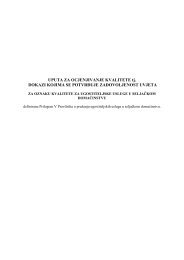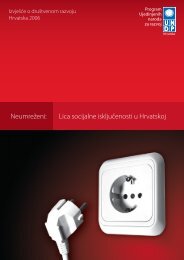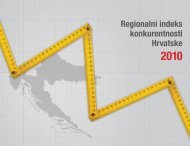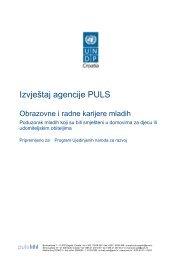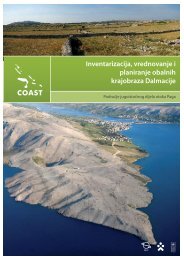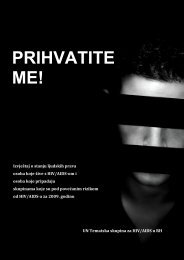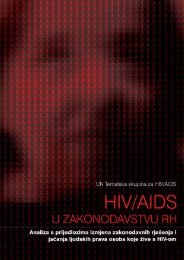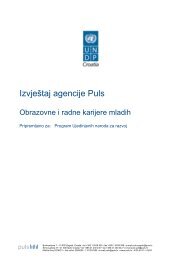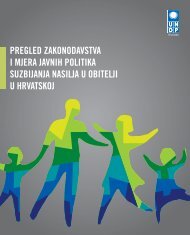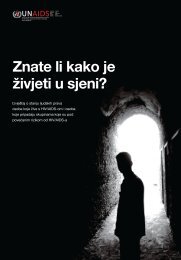WEB engleska verzija end.indd - UNDP Croatia
WEB engleska verzija end.indd - UNDP Croatia
WEB engleska verzija end.indd - UNDP Croatia
- No tags were found...
You also want an ePaper? Increase the reach of your titles
YUMPU automatically turns print PDFs into web optimized ePapers that Google loves.
THE SOCIALLY EXCLUDEDCHAPTER 31. Empowerment, which concerns women whohave experienced violence and who needpsychological support, including learning how totake responsibility for one’s own life, improvingcommunication skills, and learning how toconduct a self-appraisal of one’s abilities;2. Education on self-employment, which includeseducating women on basic entrepreneurialactivities, the use of ICT, as well as the finer pointson business communication and business culture.Economic indep<strong>end</strong>ence and reinstating thecontrol over women’s lives are the two main aimsof this component.According to information from September 2006, theCES has begun to treat women of domestic violenceas a separate group within the unemployed, whichconstitutes a very important step in the employmentservices for victims of family violence.3.10.5 Access to InformationSince 1997, and the launching of the campaign, “StopViolence against Women”, the NGO community hassucceeded in drawing the interest of many importantactors (media representatives, political parties, decisionmakers and judges) towards the problem of familyviolence. During the Campaign of 16 Days of Activismin 2001, 130 radio stations in <strong>Croatia</strong> broadcastthe radio jingle of the campaign free of charge, andby 2003 the campaign had developed regionally. 134A key problem voiced by women victimized by domesticviolence is that they have insufficient accessto information regarding their rights. According to areport published by the Women’s Counselling Centre135 in 2001 (with a total of 1,253 clients), womenwho requested help from the Counselling Centre hadreceived information about its work from the followingsources: 17.8% from fri<strong>end</strong>s/relatives; 11.2% frominstitutions; 8.1% from the media; 7.8% from NGOs;3.1% internally; and, in 52% of cases no informationwas available.To address this concern, the Ministry of the Family,Veterans’ Affairs and Intergenerational Solidarityprepared a comprehensive listing of organizationsand institutions that provide support to victims ofdomestic violence in March 2005. NGOs had earlierpublished guides for women victims of violence in1991 and 1998. The police also published the brochures“How to Help Yourself” and “Violence doesn’tLive Here”, which increased the knowledge of victimsof domestic violence as well.Although the civil campaigns have contributed themost to a change in socially accepted attitudes andstereotypes regarding domestic violence, the mediahave also played an important role by giving morespace and attention to this social phenomenon. Today,it is a common practice for the media, especiallydaily newspapers, to publish annual reports aboutdomestic violence during important days (such asSeptember 22, the national day for violence againstwomen). Although the NGO community highlightsthat their cooperation with local journalists is fair,they are critical of editors’ practices of emphasisingsensationalism and sexism in the headlines.3.10.6 Access to Housing and BasicInfrastructureWomen who are victims of domestic violence are usuallyforced to leave their homes, relying on women’sshelters or fri<strong>end</strong>s and family for support. One of theprotective measures in the Protection against FamilyViolence Act relates to the place of habitation and theprotection of women on shared premises. 136 This measurecalls for the removal of an abuser who is accusedof committing violent acts against a family member inthe same residence, if there is a danger of the accusedrepeating the offence. The measure of removal is rarelyapplied, in part because many women who are victimizedare also economically dep<strong>end</strong>ent on the abuser.As a result of numerous demands for accommodation,the Ministry of Health and Social welfare hasproposed the establishment of a larger number ofshelters, with lower capacity, in different towns and134 The topic was 17 women who were killed by their present or former partners over an 18-month period: the killed women were presentedas silhouettes on which it was indicated who killed them, where, how... Shown as silent witnesses – with the question “Violence is a CRIME,what is the PUNISHMENT?”, the silhouettes were placed at much frequented places in Zagreb, provoking silent empathy with the victimsof family violence.135 A joint project of the Autonomous Women’s House Zagreb and the Centre for Women Victims of War – ROSA..136 This measure can be issued only in the duration of up to three months.97



